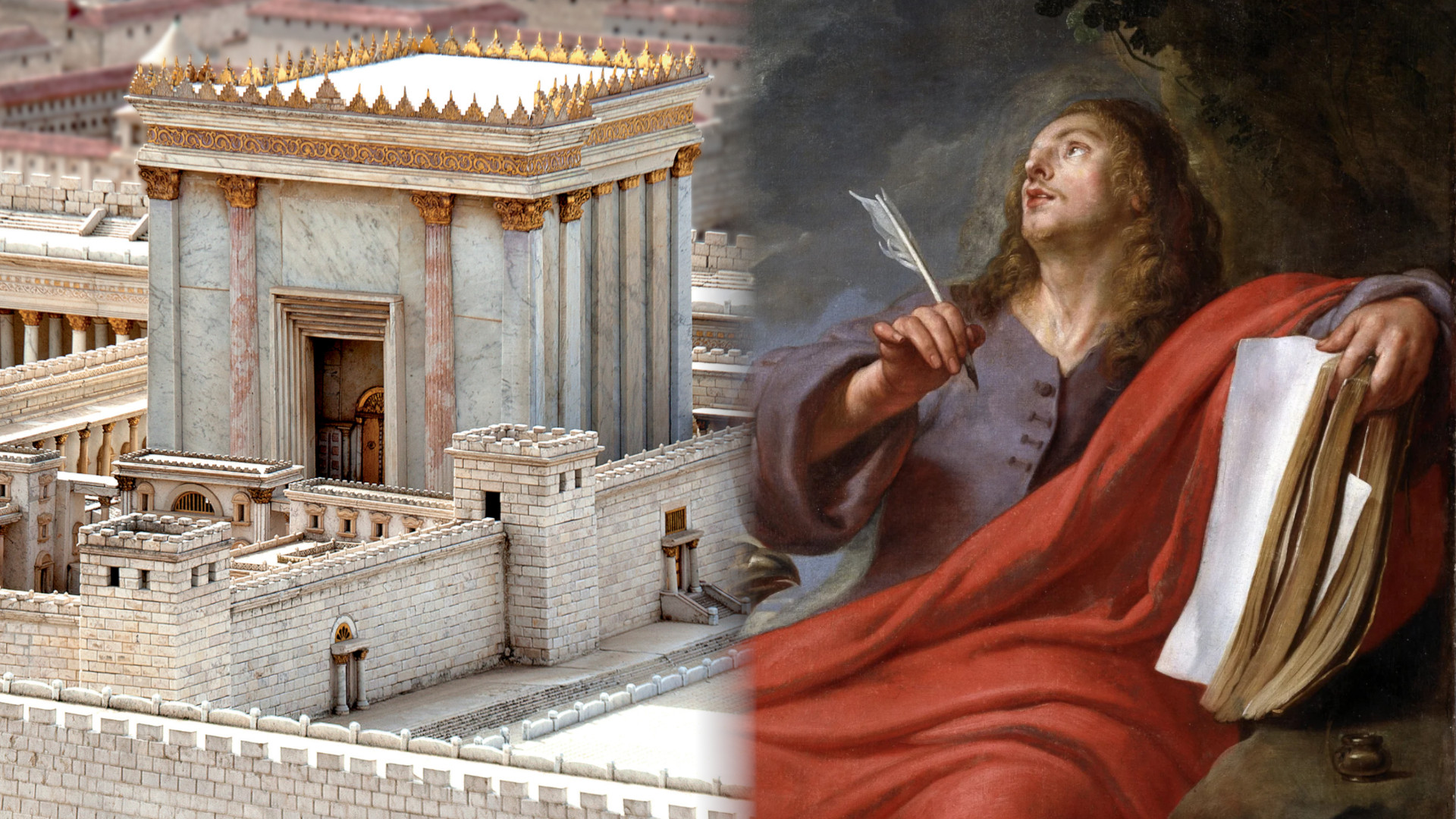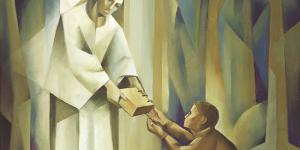You are here
How Do John’s Seven Letters Reflect the Ancient Temple?

Revelation 3:12
The Know
At the start of John’s revelation, John is instructed: “Write the things which thou hast seen, and the things which are, and the things which shall be hereafter” (Revelation 1:19). The revelation then begins with seven brief letters to seven churches in the region around Ephesus that provide significant instructions from the Lord for these churches. These personalized letters in Revelation 2–3 end with a promised blessing to those who overcome and remain true to their covenants with the Lord.
Significantly, each of these promised blessings is drawn from the imagery and language of the ancient temple. As Breck England has observed, there is “a ritual sequence to these promises,” which “apply to all saints for all time.”1 Richard D. Draper and Donald W. Parry have also observed how each of these seven blessings relate to the Garden of Eden, which was itself established as a “primal temple.”2 Therefore, these blessings “anticipate the end time when the elect will gain access to the temple in heaven” and will return to the presence of the Father, being welcomed back into His presence forevermore.3
For example, the letter to the church of Ephesus promises that “to him that overcometh will I give to eat of the tree of life, which is in the midst of the paradise of God” (Revelation 2:7). The tree of life was one of the central trees in the Garden of Eden, and Adam and Eve were forbidden from partaking of its fruit following the Fall. The tree of life would continue to play an important role in the temple as the menorah served as a representation of the tree of life with its seven branches (see Exodus 25:31–37). Therefore, as Draper and Parry observe, “John's imagery suggests that the only way to reach this tree and thus eternal life is by going to the temple. In effect, the tree of life suggests that the fall of Adam has been surmounted; spiritual death can no longer claim the individual who obeys God.”4 Similarly, Richard D. Draper and Michael D. Rhodes also note that Jewish tradition “held that partaking of the fruit of the tree was the reward for all those who achieved everlasting life,” as the righteous return to the paradise of God and enjoy His presence.5
Another clear reference to the temple ordinances and its blessings can be found in the Lord’s blessing to the church at Sardis: “He that overcometh, the same shall be clothed in white raiment; and I will not blot out his name out of the book of life, but I will confess his name before my Father, and before his angels” (Revelation 3:5). The reception of new, sacred clothing is a key aspect to temple worship, both ancient and modern. These sacred garments are connected to a variety of significant meanings in the scriptures and allow Saints to emulate exalted beings in preparation for entering the Lord’s presence.6 Indeed, Revelation 3:4 promises that the righteous will “walk with me in white.” As Draper and Rhodes have observed, “echoes of temple worship can be heard, for it is in those holy buildings, as one wears white and enters into vicarious saving work, that he or she walks with God.”7
These sacred garments can also be traced back to the Garden of Eden. Before being expelled from Eden, “unto Adam also and to his wife did the Lord God make coats [garments] of skins, and clothed them” (Genesis 3:21). After Adam and Eve received these garments, the Lord declared, “Behold, the man is become as one of us,” now knowing good and evil and being clothed in sacred garments (Genesis 3:22).
Finally, another noteworthy parallel is found in the Lord’s promise to the churches in Philadelphia and Pergamos: “Him that overcometh will I make a pillar in the temple of my God, and he shall go no more out: and I will write upon him the name of my God, and the name of the city of my God, which is new Jerusalem, which cometh down out of heaven from my God: and I will write upon him my new name” (Revelation 3:12). Similarly, the Lord will also “give him a white stone, and in the stone a new name written, which no man knoweth saving he that receiveth it” (Revelation 2:17).8 This is similar to the Lord naming Adam and Eve in the Garden of Eden: “In the day that God created man, in the likeness of God made he him; male and female created he them; and blessed them, and called their name Adam” (Genesis 5:1–2).
The reception of new, sacred names draws on coronation rituals throughout the ancient Near East, which typically took place in a temple precinct. In many cases, multiple names were given to a new king, reminiscent of the divine names given to the future Messiah in Isaiah 9:6 and the multiple names given to the temple petitioner in these two verses.9 Additionally, the coronation of some biblical kings was also connected to a pillar in the temple, which served as a “functional symbol of royal stability and hence the institution of kingship.”10 As such, the temple petitioner who keeps their covenants are ultimately promised by these blessings to become kings and queens in the kingdom of heaven.11
The Why
Throughout his seven letters, John addresses these seven churches collectively against the imminent dangers of apostasy. As noted by Draper and Parry, “apostasy was running full steam, fueled by false prophets and apostles. Entire branches were ignorantly or willfully being overrun by it. The message to the churches sounded a clear warning that God would abandon them unless they returned to him.”12 Only by remembering and staying true to their temple covenants can the Saints, then and now, survive turbulent times, avoid the pains of the second death, and hope to return to the presence of God.
While we are not necessarily faced with exactly the same challenges faced by the ancient Church, we will likewise find ourselves in need of the Lord’s guidance and blessings that come through the covenants we have made with Him in holy temples. As recently explained by Elder Dale G. Renlund, “Keeping covenants made in baptismal fonts and in temples also provides us with strength to withstand mortality’s trials and heartaches. The doctrine associated with these covenants eases our way and provides hope, comfort, and peace.”13
Ultimately, those who overcome all trials and remain faithful to the Lord will be heirs of the ultimate blessing: “To him that overcometh will I grant to sit with me in my throne, even as I also overcame, and am set down with my Father in his throne” (Revelation 3:21). This final blessing, the promise of living with God and becoming like Him, is our ultimate goal as we strive to draw closer to our Father in Heaven.14 Ultimately, through the temple, we can gain this and all other promised blessings as we strive to draw nearer to Him.
Further Reading
Richard D. Draper and Donald W. Parry, “Seven Promises to Those Who Overcome: Aspects of Genesis 2–3 in the Seven Letters,” in The Temple in Time and Eternity, ed. Donald W. Parry and Stephen D. Ricks (Provo, UT: Foundation for Ancient Research and Mormon Studies, 1999), 121–141.
Breck England, The Bright and Morning Star: Finding and Following Jesus in the Book of Revelation (Orem, UT: Interpreter Foundation; Salt Lake City, UT: Eborn Books, 2023), 41–64.
Richard D. Draper and Michael D. Rhodes, The Revelation of John the Apostle (Provo, UT: BYU Studies, 2013), 82–131.
- 1. Breck England, The Bright and Morning Star: Finding and Following Jesus in the Book of Revelation (Orem, UT: Interpreter Foundation; Salt Lake City, UT: Eborn Books, 2023), 51, 27.
- 2. See Richard D. Draper and Donald W. Parry, “Seven Promises to Those Who Overcome: Aspects of Genesis 2–3 in the Seven Letters,” in The Temple in Time and Eternity, ed. Donald W. Parry and Stephen D. Ricks (Provo, UT: Foundation for Ancient Research and Mormon Studies, 1999), 138, table 2.
- 3. Draper and Parry, “Seven Promises to Those Who Overcome,” 122. For a chart showing twenty-four ways the book of Revelation draws on earthly temple elements in portraying the temple in heaven, see John W. Welch and John F. Hall, Charting the New Testament (Provo, UT: Foundation for Ancient Research and Mormon Studies, 2002), chart 17-4. Furthermore, another helpful chart regarding the messages given to the seven churches can be found in Welch and Hall, Charting the New Testament, chart 17-2.
- 4. Draper and Parry, “Seven Promises to Those Who Overcome,” 129.
- 5. Richard D. Draper and Michael D. Rhodes, The Revelation of John the Apostle (Provo, UT: BYU Studies, 2013), 89.
- 6. See Donald W. Parry, “Ancient Sacred Vestments: Scriptural Symbols and Meanings,” in Temple Insights: Proceedings of the Interpreter Matthew B. Brown Memorial Conference, “The Temple on Mount Zion,” 22 September 2012, ed. William J. Hamblin and David Rolph Seely (Orem, UT: Interpreter Foundation; Salt Lake City, UT: Eborn Books, 2014), 219–240.
- 7. Draper and Rhodes, Revelation of John the Apostle,115.
- 8. This stone with a new name is discussed in D&C 130:10–11, declaring that this stone “will become a Urim and Thummim … to each of those who come into the celestial kingdom, whereon is a new name written, which no man knoweth save he that receiveth it. The new name is the key word.”
- 9. For more on the reception of sacred names at a coronation or temple initiation, see Book of Mormon Central, “Why Did Benjamin Give Multiple Names for Jesus at the Coronation of His Son Mosiah? (Mosiah 3:8),” KnoWhy 536 (October 17, 2019); Book of Mormon Central, “Why Was Jesus Proclaimed the Son of God at His Baptism? (Mark 1:11; cf. Matthew 3:17; Luke 3:22),” KnoWhy 655 (January 24, 2023).
- 10. Richard H. Wilkinson, “The ΣΤΥΛΟΣ of Revelation 3:12 and Ancient Coronation Rites,” Journal of Biblical Literature 107, no. 3 (1988): 500.
- 11. For additional discussion on the reception of new names in these letters, see Draper and Rhodes, Revelation of John the Apostle, 101–103, 120–121.
- 12. Draper and Parry, “Seven Promises to Those Who Overcome,” 139.
- 13. Dale G. Renlund, “Accessing God’s Power through Covenants,” April 2023 general conference.
- 14. For a discussion on exaltation and becoming like God, see Book of Mormon Central, “What Did Early Christians Teach about Exaltation? (1 John 3:2),” KnoWhy 701 (November 28, 2023).
KnoWhy Citation
Related KnoWhys
Subscribe
Get the latest updates on Book of Mormon topics and research for free





